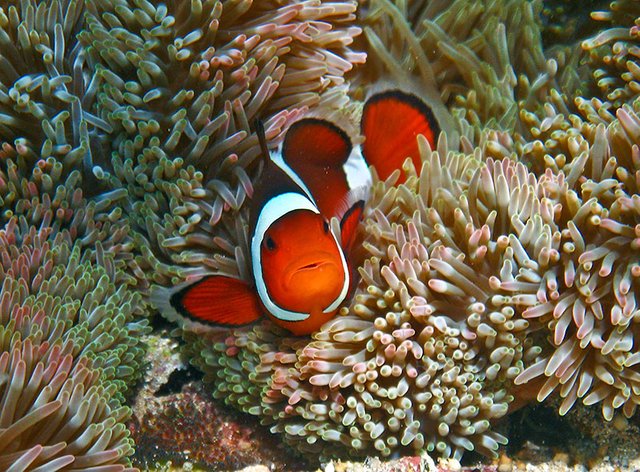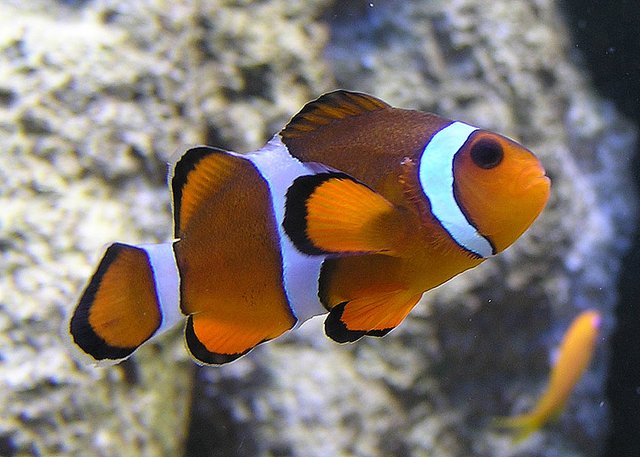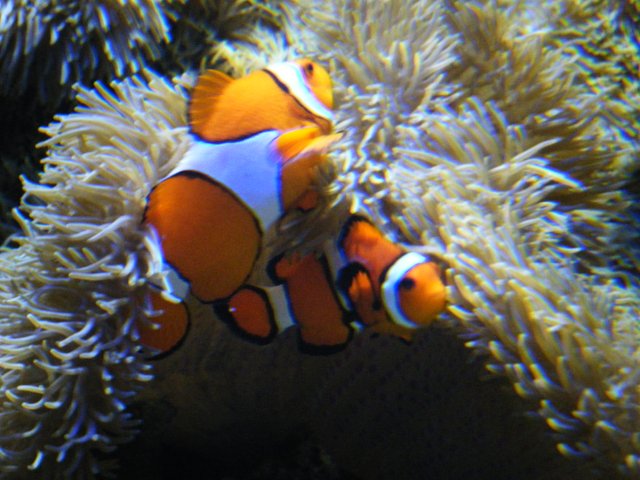How clownfish changes their sex depending on the social group (Amazing Animal Adaptations #3)
Clownfish became extremely known to the public after the Finding Nemo movie was released, but even before that they were a very popular aquarium fish. The subfamily of clownfish (called Amphiprioninae) consists of 30 recognized species, with the Orange clownfish (Amphiprion percula) and the Ocellaris clownfish (Amphiprion ocellaris) being the most well known species.

A clownfish and a sea anemone. Image by Vincent Kruger, posted under Creative Commons Universal Public Domain Dedication.
All of the clownfish lives in symbiosis with sea anemones. Their relationship it mutualistic, which means that both the clownfish and the sea anemone has an advantage to gain from the symbiosis. The clownfish gets access to leftover food from the anemone’s meals, as well as protection from predators. Every now and then it will also get a free meal from dead anemone tentacles. The anemone on the other hand, gain protection from parasites, as well as having the clownfish fend away fish that would prey on the anemone. Some theories about increased flow of water to the anemone has also been suggested, and there are likely more advantages to both partners than we are currently aware of.
Sea anemones are venomous, with a mix of toxins that includes neurotoxins. This is used to catch and eat small fish and shrimp, but the clownfish (as well as a few other types of fish) are still able to live in symbiosis with them. There are several theories as to why they can do this, including one theory that the anemone does not recognize the clownfish as prey (from the mucus coating on the scales), and therefore does not inject it with venom. The other theory is that clownfish has coevolved into being very resistant to the toxin, and are able to live somewhat peacefully unless it gets too much of the toxin. The clownfish seems to be able to survive the toxin a lot better than most fish, but it is not completely resistant, and will take harm from being exposed to it.
The sequential hermaphroditism in clownfish
Both sea anemones and clownfish are really interesting animals, but the most interesting thing about the clownfish has to be the sequential hermaphroditism. In layman terms this simply means that the animal has the ability to change from one sex to another. In the case of clownfish, they will change from male to female at one point in their lives, known as protandry. In order to understand why they do this, we must first look at their social lives.

Image by Adrian Pingstone, released as Public Domain.
The social structure of clownfish in the sea anemone
Inside a single sea anemone there lives a group of clownfish. For the Amphiprion percula species, the group will consist of 2 to 6 individuals. Among these are one female and between one and five males. The female will be the biggest and most aggressive of the individuals. One of the 1-5 males will be the dominant male, and the only one that are able to spawn together with the female.
The 0 to 4 remaining males are all in a strict hierarchy based on their body size and aggressiveness. If one of the fish dies, the one at the spot below it will take its place one step up the hierarchy. This will allow it to grow larger and more aggressive.
Why do the low-ranking fish not grow larger and try to overtake the spot above them in the hierarchy? The answer is that studies have shown that the group of clownfish will evict members of the group from the anemone if they do not comply to the rules of the hierarchy. This means that they will lose their safety in the sea anemone and have to find a new group, which is a very dangerous journey. The safe option is to stay in their spot in the hierarchy and hope to rise in the ranks instead of trying to sneak their way to the top.

Here we can clearly see which is the female! Image by Earth'sbuddy, posted under Creative Commons Attribution-Share Alike 3.0 Unported license.
So, now we have looked at the hierarchy, and you are probably wondering why there is only one female within the group. The reason is that only the most dominant fish at the top of the hierarchy is allowed to be female. If the female for some reason dies, the most dominant male will gain weight and turn into a dominant female. The now most dominant male (previously the 2nd most dominant male) will then be allowed to breed with the new female, and all the other non-breeders reach a rank higher up in the hierarchy.
This cycle will go on and on, and new fish that joins the anemone will usually be put at the bottom of the hierarchy. There will always be a dominant female, followed by a breeding male, followed by the non-breeding males.
Why does the clownfish have a dominant female, and not a dominant male at the top of the hierarchy?
The reason as to why the female is the largest and at the top of the hierarchy lies in the cost of producing gametes (cells used for creating offspring). Producing a lot of eggs are very costly in terms of energy, so only larger individuals will be able to produce a decent amount of eggs and provide the care the eggs need until the hatch. Sperm is a lot less costly (energy wise) to produce, so even if there are no large males around, the spawning process will still be able to continue without any problems.
This is not something that is unique for the clownfish, but I chose to use this fish as an example of this amazing adaptation because the clownfish are well known to most people compared to the other fish that has this adaptation.
Sources
The theory about why clownfish follow the strict hierarchy and don’t grow over a past limit: An introduction to behavioral ecology, fouth edition. By Davies, N., Krebs, J., and West, S. (p. 168).
My source for information about sequential hermaphroditism: An introduction to behavioral ecology, fouth edition. By Davies, N., Krebs, J., and West, S. (Chapter 10).
Image sources are below the images.
Thanks for reading
Thank you for reading my post about the protandry in the clownfish! This is a part of a series of post called the Amazing Animal Adaptations, so if you enjoyed this, make sure to follow me for more post in the series, as well as other animal, biology and ecology related posts in the future.
I spend a lot of time working on this original content, so if you enjoyed it, please let me know! I really love getting comments and feedback on my work.
Interesting stuff, thanks!
I'm happy you found it interesting :) Thanks for reading!
I'm a really big nature fan. Very interesting.
I'm glad you found it interesting :)
very interesting
I'm happy you found the post interesting :) Thanks for reading!